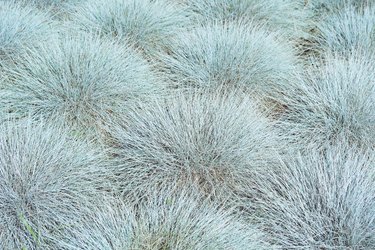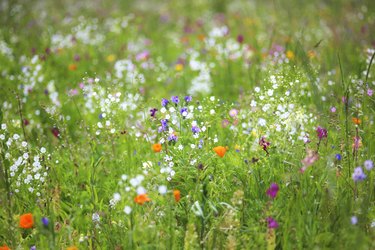
The putting-green look of a perfectly maintained grass lawn began as a status symbol for the wealthy – a visible declaration that you had enough money (and servants) to maintain it. It wasn't until the postwar years with the rise of suburban tract homes that lawns became democratized and universally available. They still take a lot of work, though, despite the inventions of lawn mowers, aerators, thatchers, string trimmers and preemergent herbicides. They're also less than friendly to the environment, replacing the diversity of native habitats with a turfgrass monoculture that needs plentiful inputs in the form of water and nonrenewable resources. If you're looking for a better option, we have 10 eco-friendly lawn alternatives for you to consider.
Tip
Before you install any lawn alternative, be sure to check on whether they're permitted under local bylaws or your homeowners' association regulations. It's also a good idea to check the National Invasive Species Information Center (or your local extension service) to make sure you don't plant anything that will become a problem for you and your neighbors.
You can also mix and match these lawn alternatives rather than trying to find one option that works across your entire yard. Creating zones in different styles creates visual interest, allows for varying conditions from one spot to the next and lets you choose more durable surfaces for high-traffic areas.
Video of the Day
1. Install Artificial Turf
Some will bristle at the idea of calling artificial turf an eco-friendly option ("It's made of, like, plastic!"), but it makes perfect sense in a lot of settings. It doesn't require watering or fertilizing, you'll never treat it with herbicides or pesticides and you and your neighbors can forget about the sound (and fumes) of the mower and string trimmer. It even provides better drainage than natural grass in many areas as long as you've prepared the area properly before installing your turf.
Video of the Day
In practical terms, it's nearly ideal. It will stand up to lots of foot traffic (which is ideal for busy families), requires almost no maintenance and will last for years. A good brand of modern artificial turf is even pleasant to walk on with bare feet, unlike the old-school kind that felt like a scrub brush. You'd actually have to look closely to recognize it as artificial.

2. Replace Your Grass With Clover
Clover is one of the most reliable replacements for grass, and you may already have some in your lawn. It's almost everything you could want: It's hardy, it requires minimal maintenance or watering, it's pet- and kid-friendly, it tolerates most soils and a bit of drought and it can stand up to light foot traffic.
Clover packs some excellent ecological credentials as well. Like beans and peas, it enriches your soil with nitrogen, and its relatively deep roots (the secret to its drought-resistance) help break up compacted or clay-rich soils to make them lighter and airier. Its sweet-smelling blossoms help attract and support pollinators, and you'll appreciate their subtle perfume as well. Best of all, clover seed is extraordinarily inexpensive. White clover is the most common option, but microclover gives a more even, grasslike appearance (though it flowers less, so the bees won't appreciate it as much).
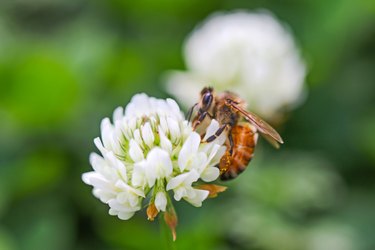
3. Go Zen With a Gravel Lawn
The ascetic look of a gravel-covered lawn isn't for everyone, but if it fits with your personal aesthetic (and your neighborhood), it's the ultimate low-maintenance lawn. Installation involves a bit of labor, especially if you consciously improve the drainage underneath to limit storm runoff, but it saves maintenance in the long term.
You'll need landscaping fabric or some other weed barrier under the gravel and clearly defined sides (lawn edging, or a hard border of stone, brick or wood) to keep the gravel in place. You should also choose a stone size greater than 20 millimeters to discourage cats from treating the area as a giant litter box. Choose a color or colors that match your decor and for maximum impact, contrast the gravel with dramatic plantings in beds or borders. Once installed, the gravel only needs occasional weeding, and it will stand up to a lot of foot traffic.
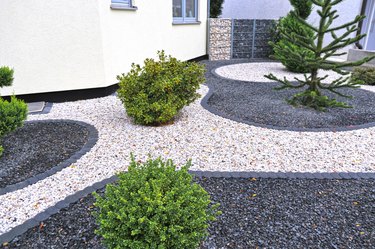
4. Use Moss for Damp or Shaded Areas
Growing turfgrass can be a real challenge if your lawn includes lots of damp and shaded areas. If that's your situation, why fight against your conditions? Harness them instead and go with greenery that actually loves shade and damp: mosses. This may rankle if you've devoted years of effort to getting moss out of your lawn, but that's actually the best argument for using it. If moss wants to grow there, listen to Mother Nature and roll with it.
There's minimal prep required. You simply poke a hole with your trowel and drop in "plugs" of your chosen moss at intervals of a few inches. In a very short time – as little as one growing season if conditions are favorable – you'll have a soft green natural carpet underfoot that requires next to no maintenance. Moss will stand up to some foot traffic, though it's not as robust as conventional turfgrasses.
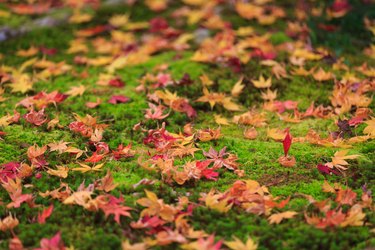
5. Xeriscape for a Drought-Tolerant Lawn
Xeriscaping is the art and science of landscaping with drought-tolerant (and usually but not always heat-tolerant) plants. It's a great option if you live in areas like the Southwest, where a drought-tolerant lawn is a must, and many of these plants are native species. Xeriscaping is harder in areas with cold winters, but your local extension service should be able to help you pick out native plants that are appropriate for any climate.
Xeriscaping usually involves setting up a graveled lawn as your base and then filling it to a greater or lesser degree with cacti; succulents; wiry, drought-tolerant shrubs; and hardy, ornamental grasses. These are very often prickly and certainly don't add up to the kind of lawn you'll run across barefoot or stretch out on to sunbathe, so be sure to leave suitable spaces and pathways for foot traffic where they're needed. Once installed, maintenance consists mainly of occasional pruning of your plants and picking out any weeds that invade your space.

6. Go Native With Species From Your Area
One of the most ecologically powerful ways you can repurpose your lawn is by recreating the original, biodiverse habitat of your area. Reestablishing native plants is a long-term project (it'll take you a while), and it's also the lawn alternative that's likeliest to get significant pushback from your neighbors and community. You may have to restrict your re-wilding efforts to the backyard and find something more conventional for the front of your house. Consult your local universities and extension service for some guidance on which plants are most authentic and least invasive for your neighbors.
You'll also need to strategize, first planting anchor species and then filling in around them with smaller, low-growing plants that will benefit from their shade and shelter. Re-wilding does have some downsides: Your yard will be less versatile for human use (so you may want to carve out a few spaces for yourself), and you'll need to be aware that as plants, bugs and critters colonize your yard, some of them will be species you might not entirely appreciate.
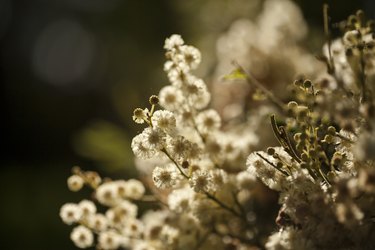
7. Plant an Aromatic Herb Lawn
Ideally, you'd replace your turfgrass with low-growing plants that offer a similar look to the casual eye. If those plants happen to be aromatic and decorative in their own right, so much the better. Surprisingly, herbs – yes, herbs! – can be a beautiful and practical replacement for the grass on your lawn.
Chamomile is one strong option, bringing a grasslike appearance; sweet scent; and small, daisylike flowers to your lawn (and like clover, it adds nitrogen to the soil). Vanilla-scented sweet woodruff only grows about 2 inches tall and crowds out weeds. Unlike chamomile, which appreciates full sun, woodruff favors shade. Corsican mint is shorter and less invasive than other mints, and it tolerates a degree of foot traffic. Creeping thyme is aromatic, tolerates poor soils and drought and some varieties provide beautiful blossoms as well. As a bonus, most of these can be used in cooking and herbal teas as well.
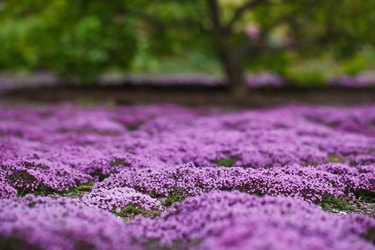
8. Go With Vivid Ground Covers
Ground-cover plants, like creeping thyme, are often used in rock gardens and borders to provide an accent, but they'll work just as well to cover your entire lawn. You can mix and match to create zones for each area of your lawn, which has the added benefit of creating more visual interest.
You can use stonecrop and other succulents for stony, hot areas; lily of the valley for shady areas; and phlox or creeping thyme for direct sun. Intersperse the areas of ground cover with footpaths of gravel and mulch or with flagstones to allow for foot traffic. This is both a practical choice and an aesthetic one, framing each bed as a little oasis of color and texture. Ground covers are great at crowding out weeds (that's basically what they're for) and generally require little maintenance once they're established. Some require more care and watering than others, so be sure you're picking varieties that are suited to your climate and growing conditions.
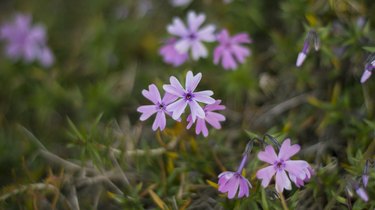
9. Put In a Wildflower Meadow
This is a close cousin to the notion of re-wilding your yard with native plants, but it's a more neighbor-friendly option. Instead of returning your grass lawn to its native state, you'll plant a mix of wildflowers suitable to your climate and let them grow to their natural height – anything from a few inches to waist-high – in a very natural-looking meadow.
Once established, a wildflower meadow requires little maintenance. It might benefit from an occasional watering during very dry periods, but otherwise, there's not much you'll need to do. The varying heights, colors and textures of the flowers will give your lawn tremendous visual appeal, and it will become a magnet for all of the area's pollinators (who will be very happy about your decision). It's a win-win and a big one for both yourself and the environment.

10. Switch to Alternative Grasses
If you like the idea of a more eco-friendly alternative but don't want to stray too far from the traditional lawn's aesthetic, one option is to replace your turfgrass with low-maintenance alternative grasses. Low-growing varieties of fescue are a good choice because they're heat- and drought-resistant and give you a lawn that looks pretty normal (but requires little or no mowing and minimal maintenance). Buffalograss and blue grama are slow-growing, water-efficient, warm-season grasses that stay green in midsummer when others yellow and can be planted separately or as a blend. Taller ornamental grasses and sedges tend to grow in clumps, which can be used to fill in spaces where you need some visual interest and don't necessarily need to walk there.
